初三英语被动语态知识点整理
- 格式:docx
- 大小:18.37 KB
- 文档页数:2
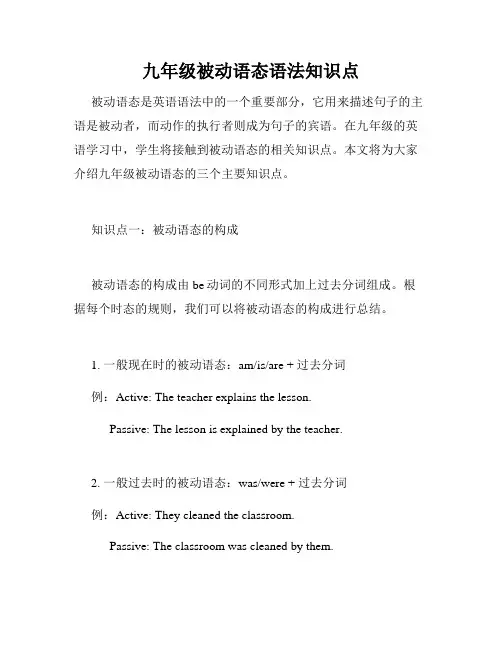
九年级被动语态语法知识点被动语态是英语语法中的一个重要部分,它用来描述句子的主语是被动者,而动作的执行者则成为句子的宾语。
在九年级的英语学习中,学生将接触到被动语态的相关知识点。
本文将为大家介绍九年级被动语态的三个主要知识点。
知识点一:被动语态的构成被动语态的构成由be动词的不同形式加上过去分词组成。
根据每个时态的规则,我们可以将被动语态的构成进行总结。
1. 一般现在时的被动语态:am/is/are + 过去分词例:Active: The teacher explains the lesson.Passive: The lesson is explained by the teacher.2. 一般过去时的被动语态:was/were + 过去分词例:Active: They cleaned the classroom.Passive: The classroom was cleaned by them.3. 一般将来时的被动语态:will be + 过去分词例:Active: She will write a letter.Passive: A letter will be written by her.4. 现在进行时的被动语态:am/is/are + being + 过去分词例:Active: They are building a new house.Passive: A new house is being built by them.5. 过去进行时的被动语态:was/were + being + 过去分词例:Active: He was repairing his bike.Passive: His bike was being repaired by him.6. 现在完成时的被动语态:has/have been + 过去分词例:Active: She has written a book.Passive: A book has been written by her.知识点二:被动语态的用法被动语态在英语中有着重要的应用。
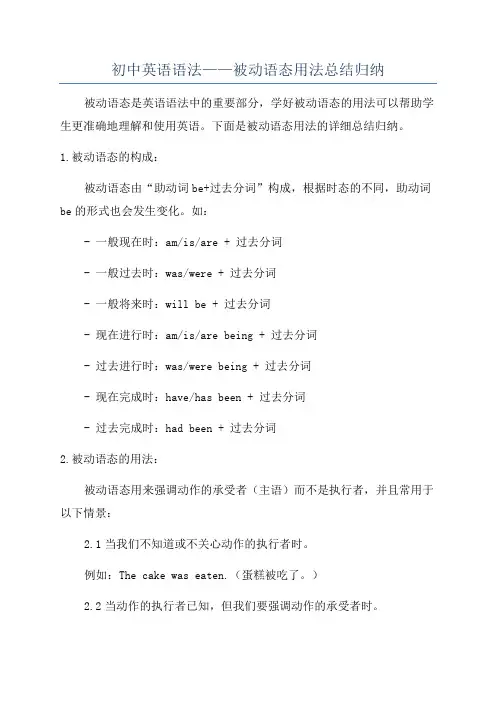
初中英语语法——被动语态用法总结归纳被动语态是英语语法中的重要部分,学好被动语态的用法可以帮助学生更准确地理解和使用英语。
下面是被动语态用法的详细总结归纳。
1.被动语态的构成:被动语态由“助动词be+过去分词”构成,根据时态的不同,助动词be的形式也会发生变化。
如:- 一般现在时:am/is/are + 过去分词- 一般过去时:was/were + 过去分词- 一般将来时:will be + 过去分词- 现在进行时:am/is/are being + 过去分词- 过去进行时:was/were being + 过去分词- 现在完成时:have/has been + 过去分词- 过去完成时:had been + 过去分词2.被动语态的用法:被动语态用来强调动作的承受者(主语)而不是执行者,并且常用于以下情景:2.1当我们不知道或不关心动作的执行者时。
例如:The cake was eaten.(蛋糕被吃了。
)2.2当动作的执行者已知,但我们要强调动作的承受者时。
例如:The house was built by my grandfather.(这座房子是我爷爷建的。
)2.3当我们要避免使用第一人称或第二人称时。
例如:Mistakes were made.(犯了错误。
)3.被动语态的注意事项:在使用被动语态时,需要注意以下几点:3.1表示动作的动词要用过去分词形式。
过去分词的形式有规律变化和不规律变化两种。
如:- 规律变化:原形 + ed,例如:played, watched, called- 不规律变化:需要记忆,例如:born, written, eaten3.2被动句的主语是动作的承受者,通常出现在句子的前面。
如:- 主动语态:I cooked dinner.(我做了晚饭。
)- 被动语态:Dinner was cooked by me.(晚饭是我做的。
)3.3 不及物动词不能构成被动语态。
不及物动词没有宾语,因此不能强调动作的承受者。
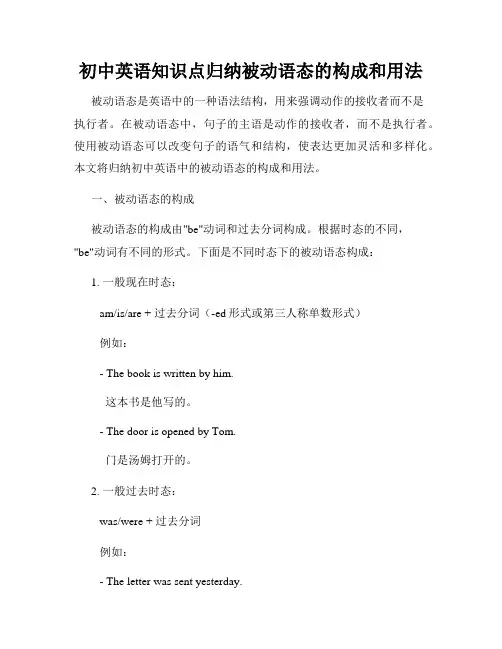
初中英语知识点归纳被动语态的构成和用法被动语态是英语中的一种语法结构,用来强调动作的接收者而不是执行者。
在被动语态中,句子的主语是动作的接收者,而不是执行者。
使用被动语态可以改变句子的语气和结构,使表达更加灵活和多样化。
本文将归纳初中英语中的被动语态的构成和用法。
一、被动语态的构成被动语态的构成由"be"动词和过去分词构成。
根据时态的不同,"be"动词有不同的形式。
下面是不同时态下的被动语态构成:1. 一般现在时态:am/is/are + 过去分词(-ed形式或第三人称单数形式)例如:- The book is written by him.这本书是他写的。
- The door is opened by Tom.门是汤姆打开的。
2. 一般过去时态:was/were + 过去分词例如:- The letter was sent yesterday.这封信昨天被寄出了。
- The cake was made by my mom.这个蛋糕是我妈妈做的。
3. 一般将来时态:will be + 过去分词例如:- The package will be delivered tomorrow.这个包裹将会在明天被送到。
- The decision will be made by the committee.决定将由委员会做出。
4. 现在进行时态:am/is/are being + 过去分词例如:- The house is being cleaned by the maid.这所房子正在被女佣清理。
- The project is being discussed by the team.这个项目正在团队讨论中。
5. 过去进行时态:was/were being + 过去分词例如:- The car was being repaired last week.这辆车上周正在维修。
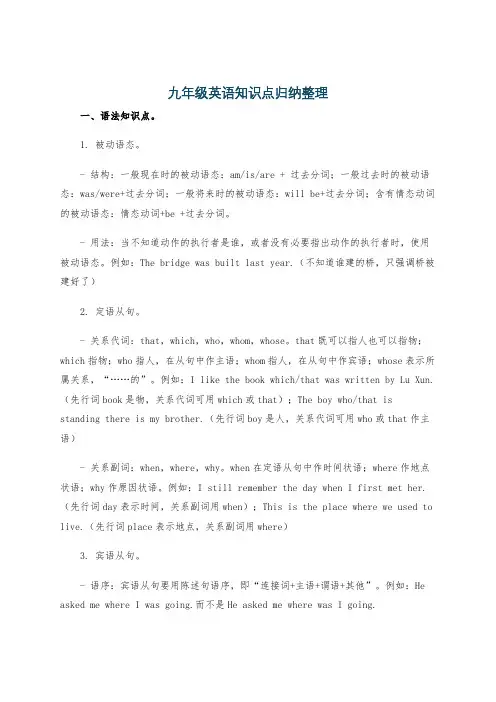
九年级英语知识点归纳整理一、语法知识点。
1. 被动语态。
- 结构:一般现在时的被动语态:am/is/are + 过去分词;一般过去时的被动语态:was/were+过去分词;一般将来时的被动语态:will be+过去分词;含有情态动词的被动语态:情态动词+be +过去分词。
- 用法:当不知道动作的执行者是谁,或者没有必要指出动作的执行者时,使用被动语态。
例如:The bridge was built last year.(不知道谁建的桥,只强调桥被建好了)2. 定语从句。
- 关系代词:that,which,who,whom,whose。
that既可以指人也可以指物;which指物;who指人,在从句中作主语;whom指人,在从句中作宾语;whose表示所属关系,“……的”。
例如:I like the book which/that was written by Lu Xun.(先行词book是物,关系代词可用which或that);The boy who/that is standing there is my brother.(先行词boy是人,关系代词可用who或that作主语)- 关系副词:when,where,why。
when在定语从句中作时间状语;where作地点状语;why作原因状语。
例如:I still remember the day when I first met her.(先行词day表示时间,关系副词用when);This is the place where we used to live.(先行词place表示地点,关系副词用where)3. 宾语从句。
- 语序:宾语从句要用陈述句语序,即“连接词+主语+谓语+其他”。
例如:He asked me where I was going.而不是He asked me where was I going.- 连接词:that(无意义,可省略,在从句中不作成分);if/whether(“是否”,在从句中不作成分);特殊疑问词(如what,when,where,why,how等,在从句中作相应的成分)。
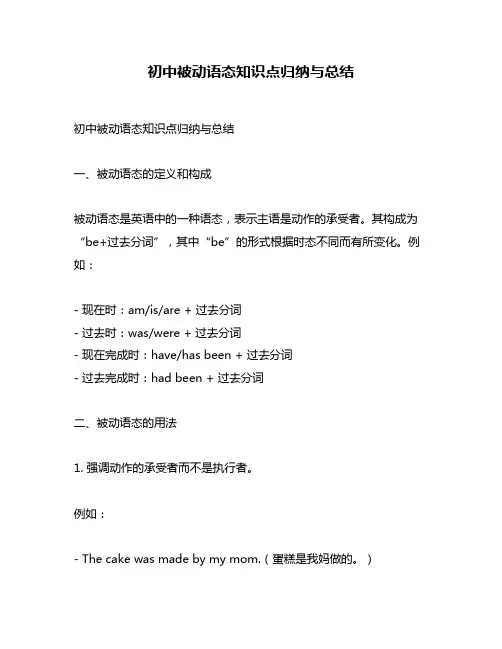
初中被动语态知识点归纳与总结初中被动语态知识点归纳与总结一、被动语态的定义和构成被动语态是英语中的一种语态,表示主语是动作的承受者。
其构成为“be+过去分词”,其中“be”的形式根据时态不同而有所变化。
例如:- 现在时:am/is/are + 过去分词- 过去时:was/were + 过去分词- 现在完成时:have/has been + 过去分词- 过去完成时:had been + 过去分词二、被动语态的用法1. 强调动作的承受者而不是执行者。
例如:- The cake was made by my mom.(蛋糕是我妈做的。
)2. 当执行者不确定或无需明确时。
例如:- The window was broken.(窗户破了。
)3. 当执行者已知但无需强调时。
例如:- The book was written by Mark Twain.(这本书是马克·吐温写的。
)4. 在科学、新闻报道等中常用被动语态。
例如:- The new drug has been tested on animals.(这种新药已经在动物身上进行了测试。
)三、被动语态与主动语态的转换1. 主动变被动:将主语改为宾语,动词变为过去分词,加上适当的助动词。
例如:- 主动:My mom made the cake.(我妈做了蛋糕。
)- 被动:The cake was made by my mom.(蛋糕是我妈做的。
)2. 被动变主动:将宾语改为主语,去掉助动词,将过去分词变为一般现在时。
例如:- 被动:The cake was made by my mom.(蛋糕是我妈做的。
)- 主动:My mom makes the cake.(我妈做蛋糕。
)四、被动语态的注意事项1. 被动语态只能用于及物动词。
例如:- 正确:The book was read by me.(这本书被我读了。
)- 错误:I was slept last night.(昨晚我被睡觉了。
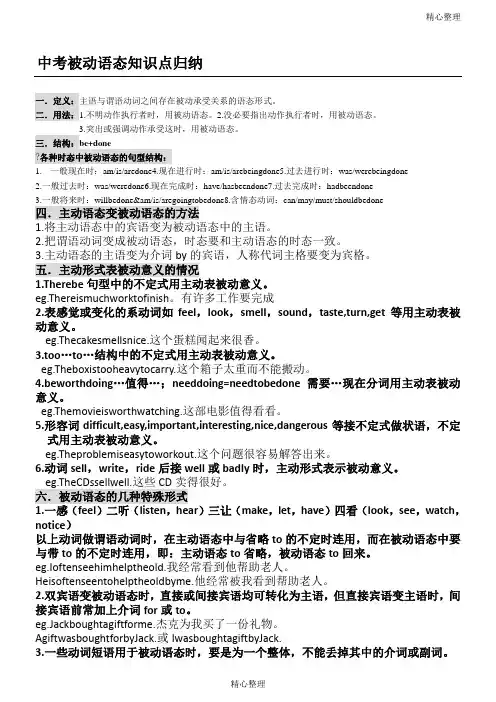
精心整理精心整理中考被动语态知识点归纳一.定义:主语与谓语动词之间存在被动承受关系的语态形式。
二.用法:1.不明动作执行者时,用被动语态。
2.没必要指出动作执行者时,用被动语态。
3.突出或强调动作承受这时,用被动语态。
三.结构:be+done?各种时态中被动语态的句型结构:1. 一般现在时:am/is/aredone4.现在进行时:am/is/arebeingdone5.过去进行时:was/werebeingdone2.一般过去时:was/weredone6.现在完成时:have/hasbeendone7.过去完成时:hadbeendone不定,notice )以上动词做谓语动词时,在主动语态中与省略to 的不定时连用,而在被动语态中要与带to 的不定时连用,即:主动语态to 省略,被动语态to 回来。
eg.Ioftenseehimhelptheold.我经常看到他帮助老人。
Heisoftenseentohelptheoldbyme.他经常被我看到帮助老人。
2.双宾语变被动语态时,直接或间接宾语均可转化为主语,但直接宾语变主语时,间接宾语前常加上介词for 或to 。
eg.Jackboughtagiftforme.杰克为我买了一份礼物。
AgiftwasboughtforbyJack.或IwasboughtagiftbyJack.3.一些动词短语用于被动语态时,要是为一个整体,不能丢掉其中的介词或副词。
精心整理精心整理eg.Wemustfinishtheworkcarefully.我们必须认真完成这项工作。
Theworkmustbefinishedcarefullybyus.4.带有复合宾语的动词变为被动语态时,只变宾语为被动句主语,宾语补足语不变。
eg.Iaskedhertogowithme.我叫她跟我一起去。
Shewasaskedtogowithme.七.不能用被动语态的情况1.谓语动词为不及物动词或不及物动词短语时,不用被动语态。
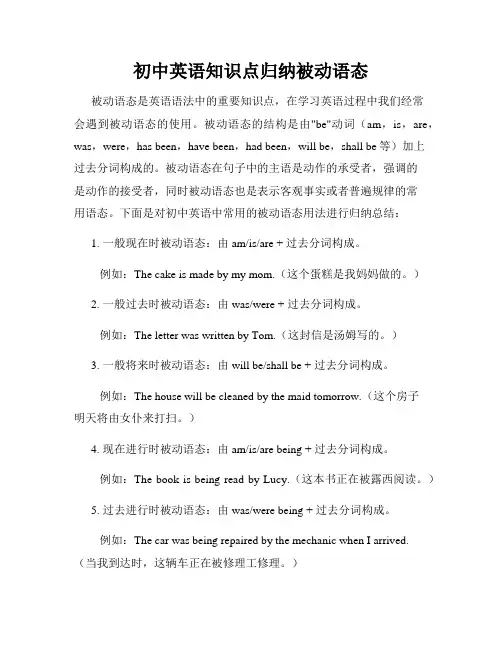
初中英语知识点归纳被动语态被动语态是英语语法中的重要知识点,在学习英语过程中我们经常会遇到被动语态的使用。
被动语态的结构是由"be"动词(am,is,are,was,were,has been,have been,had been,will be,shall be等)加上过去分词构成的。
被动语态在句子中的主语是动作的承受者,强调的是动作的接受者,同时被动语态也是表示客观事实或者普遍规律的常用语态。
下面是对初中英语中常用的被动语态用法进行归纳总结:1. 一般现在时被动语态:由am/is/are + 过去分词构成。
例如:The cake is made by my mom.(这个蛋糕是我妈妈做的。
)2. 一般过去时被动语态:由was/were + 过去分词构成。
例如:The letter was written by Tom.(这封信是汤姆写的。
)3. 一般将来时被动语态:由will be/shall be + 过去分词构成。
例如:The house will be cleaned by the maid tomorrow.(这个房子明天将由女仆来打扫。
)4. 现在进行时被动语态:由am/is/are being + 过去分词构成。
例如:The book is being read by Lucy.(这本书正在被露西阅读。
)5. 过去进行时被动语态:由was/were being + 过去分词构成。
例如:The car was being repaired by the mechanic when I arrived.(当我到达时,这辆车正在被修理工修理。
)6. 情态动词被动语态:由情态动词(can,could,may,might,must,should,would等)+ be + 过去分词构成。
例如:The film can be watched online.(这部电影可以在线观看。
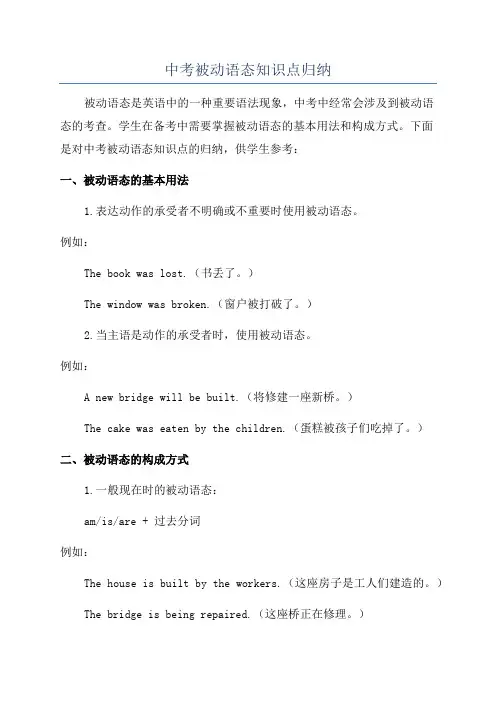
中考被动语态知识点归纳被动语态是英语中的一种重要语法现象,中考中经常会涉及到被动语态的考查。
学生在备考中需要掌握被动语态的基本用法和构成方式。
下面是对中考被动语态知识点的归纳,供学生参考:一、被动语态的基本用法1.表达动作的承受者不明确或不重要时使用被动语态。
例如:The book was lost.(书丢了。
)The window was broken.(窗户被打破了。
)2.当主语是动作的承受者时,使用被动语态。
例如:A new bridge will be built.(将修建一座新桥。
)The cake was eaten by the children.(蛋糕被孩子们吃掉了。
)二、被动语态的构成方式1.一般现在时的被动语态:am/is/are + 过去分词例如:The house is built by the workers.(这座房子是工人们建造的。
)The bridge is being repaired.(这座桥正在修理。
)2.一般过去时的被动语态:was/were + 过去分词例如:The book was written by Mark Twain.(这本书是马克吐温写的。
)The cake was made by my mother.(这个蛋糕是我妈妈做的。
)3.现在进行时的被动语态:am/is/are + being + 过去分词例如:The letter is being written by Tom.(这封信是汤姆在写。
)The garden is being watered by my father.(这个花园正在被我爸爸浇水。
)4.过去进行时的被动语态:was/were + being + 过去分词例如:The house was being built when it started raining.(这座房子在下雨时正在建造。
)The car was being repaired in the garage.(这辆车在车库里正在修理。
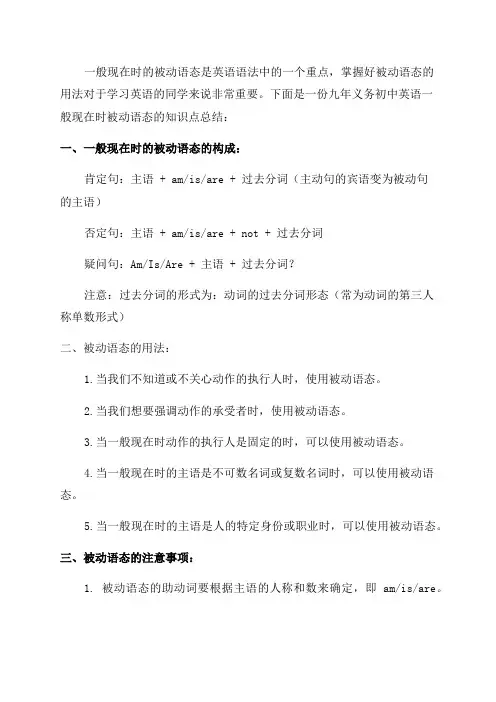
一般现在时的被动语态是英语语法中的一个重点,掌握好被动语态的用法对于学习英语的同学来说非常重要。
下面是一份九年义务初中英语一般现在时被动语态的知识点总结:一、一般现在时的被动语态的构成:肯定句:主语 + am/is/are + 过去分词(主动句的宾语变为被动句的主语)否定句:主语 + am/is/are + not + 过去分词疑问句:Am/Is/Are + 主语 + 过去分词?注意:过去分词的形式为:动词的过去分词形态(常为动词的第三人称单数形式)二、被动语态的用法:1.当我们不知道或不关心动作的执行人时,使用被动语态。
2.当我们想要强调动作的承受者时,使用被动语态。
3.当一般现在时动作的执行人是固定的时,可以使用被动语态。
4.当一般现在时的主语是不可数名词或复数名词时,可以使用被动语态。
5.当一般现在时的主语是人的特定身份或职业时,可以使用被动语态。
三、被动语态的注意事项:1. 被动语态的助动词要根据主语的人称和数来确定,即am/is/are。
2. 在被动语态中,主语变为了动作的承受者,动作的执行者成为了介词by的宾语。
3. 动作执行人在被动语态中可以省略,也可以用by短语表示。
4. 当动作执行人为人的特定身份或职业时,在被动语态中可以将它放在by短语的前面。
5.当被动句中存在情态动词时,情态动词在被动句中的位置是在助动词之后。
四、被动语态的修辞变化:1.被动语态可以通过在不同位置上加入时间状语或地点状语来改变句子的修辞效果。
2.被动语态可以通过在句子中加入介词短语或从句来增加句子的修辞内容。
3.被动语态可以通过在句子中加入定语从句或非限定性定语从句来扩展句子的信息。
五、九年义务初中英语一般现在时被动语态的常见句型:2. 主动句:He sells fruits in the market.被动句:Fruits are sold in the market (by him).3. 主动句:They teach us English every day.被动句:We are taught English by them every day.4. 主动句:My mother cooks dinner for us.被动句:Dinner is cooked for us by my mother.5. 主动句:She washes her car once a week.被动句:Her car is washed once a week (by her).通过掌握以上的知识点,同学们能够更好地理解和使用九年义务初中英语一般现在时的被动语态。
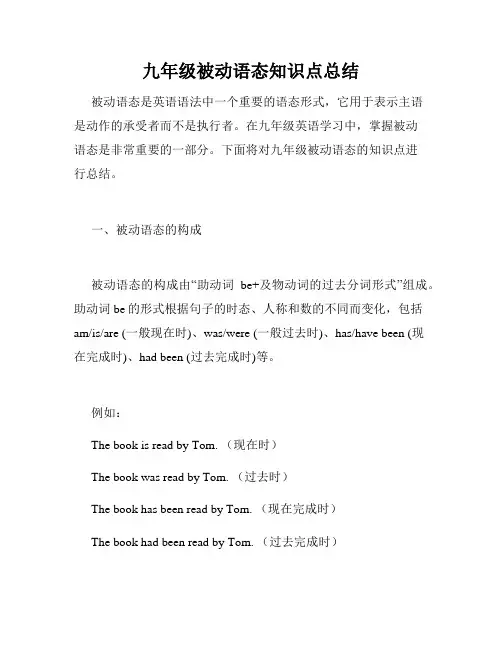
九年级被动语态知识点总结被动语态是英语语法中一个重要的语态形式,它用于表示主语是动作的承受者而不是执行者。
在九年级英语学习中,掌握被动语态是非常重要的一部分。
下面将对九年级被动语态的知识点进行总结。
一、被动语态的构成被动语态的构成由“助动词be+及物动词的过去分词形式”组成。
助动词be的形式根据句子的时态、人称和数的不同而变化,包括am/is/are (一般现在时)、was/were (一般过去时)、has/have been (现在完成时)、had been (过去完成时)等。
例如:The book is read by Tom. (现在时)The book was read by Tom. (过去时)The book has been read by Tom. (现在完成时)The book had been read by Tom. (过去完成时)二、被动语态的用法1. 强调动作的承受者或对象更重要时,常常使用被动语态。
例如:The cake was made by my mother. (强调动作的执行者是“我的妈妈”)The movie will be watched by millions of people.(强调动作的承受者是“数百万人”)2. 当我们不知道或不关心动作的执行者时,可以使用被动语态。
例如:The window was broken.(我们不知道是谁打破了窗户)The car was stolen.(我们不关心偷车的人是谁)3. 由于某种原因或出于某种需要,我们需要隐藏动作执行者的身份时,可以使用被动语态。
例如:The decision has been made.(出于某种原因,我们不想透露决策的执行者)三、使用被动语态时需要注意的问题1. 当动词为不及物动词时,无法使用被动语态。
例如:They sleep on the big bed. (不可以说:The big bed is slept by them.)2. 当动词为感官动词(如see, hear, watch等)时,构成被动语态时需要注意动词后面的介词。
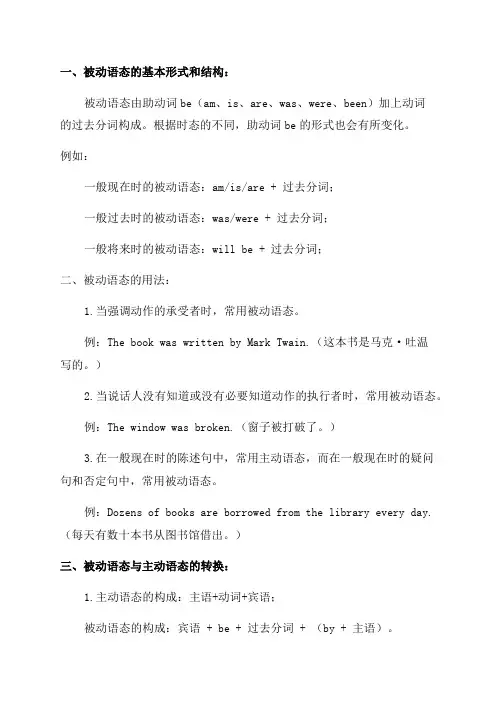
一、被动语态的基本形式和结构:被动语态由助动词be(am、is、are、was、were、been)加上动词的过去分词构成。
根据时态的不同,助动词be的形式也会有所变化。
例如:一般现在时的被动语态:am/is/are + 过去分词;一般过去时的被动语态:was/were + 过去分词;一般将来时的被动语态:will be + 过去分词;二、被动语态的用法:1.当强调动作的承受者时,常用被动语态。
例:The book was written by Mark Twain.(这本书是马克·吐温写的。
)2.当说话人没有知道或没有必要知道动作的执行者时,常用被动语态。
例:The window was broken.(窗子被打破了。
)3.在一般现在时的陈述句中,常用主动语态,而在一般现在时的疑问句和否定句中,常用被动语态。
例:Dozens of books are borrowed from the library every day.(每天有数十本书从图书馆借出。
)三、被动语态与主动语态的转换:1.主动语态的构成:主语+动词+宾语;被动语态的构成:宾语 + be + 过去分词 + (by + 主语)。
例如:主动语态:He wrote a letter yesterday.(昨天他写了一封信。
)被动语态:A letter was written by him yesterday.(昨天一封信被他写了。
)2.被动语态转换的注意事项:a.如果主动句中的宾语是由人称代词构成的,可以直接将其改为被动句的主语。
b.如果主动句中有间接宾语和直接宾语,将间接宾语变为被动句的主语,直接宾语保持不变。
c. 如果主动句中的宾语是由关系代词who或which引导的从句,常省略by短语。
例如:主动语态:They built a new school in our village.(他们在我们村修建了一所新学校。
)被动语态:A new school was built in our village by them.(在我们村有一所新学校被他们修建了。
中考英语被动语态知识点整理在中考英语中,被动语态是一个重要的语法知识点。
理解和掌握被动语态对于我们正确运用英语、提高语言表达能力有着重要的意义。
接下来,让我们一起对中考英语被动语态的相关知识进行全面的整理。
一、被动语态的基本概念被动语态表示主语是动作的承受者,即行为动作的对象。
例如:“The book is read by me”(这本书被我读。
)在这个句子中,“the book”是动作“read”的承受者,而不是执行者。
二、被动语态的构成被动语态由“be 动词+及物动词的过去分词”构成。
其中,be 动词的形式根据时态和主语的人称、数而变化。
1、一般现在时的被动语态:am/is/are +过去分词例如:“English is spoken all over the world”(英语在全世界被说。
)2、一般过去时的被动语态:was/were +过去分词例如:“The bridge was built last year”(这座桥去年被建造。
)3、一般将来时的被动语态:will be +过去分词或 be going to be+过去分词例如:“The sports meeting will be held next week”(运动会将在下周举行。
)4、现在进行时的被动语态:am/is/are + being +过去分词例如:“The problem is being discussed now”(这个问题正在被讨论。
)5、过去进行时的被动语态:was/were + being +过去分词例如:“The house was being painted when I arrived”(我到达时,房子正在被粉刷。
)6、现在完成时的被动语态:have/has been +过去分词例如:“Many trees have been planted by us”(我们已经种了很多树。
)7、过去完成时的被动语态:had been +过去分词例如:“The work had been finished before he came”(在他来之前,工作已经完成了。
初中英语被动语态(知识点+练习题,含答案)语态是动词的一种形式,用于表示句子中主语和谓语动词的关系。
主动语态表示主语是动作的执行者,而被动语态则表示主语是动作的承受者。
被动语态只能用于及物动词。
一.被动语态的时态:1.一般现在时的被动语态:am /is/ are +动词的过去分词2.一般过去时的被动语态:was /were +动词的过去分词3.一般将来时的被动语态:will be +动词的过去分词4.现在进行时的被动语态:am /is /are +being +动词的过去分词5.现在完成时的被动语态:have /has +been +动词的过去分词6.情态动词的被动语态:情态动词+ be +动词的过去分词二.被动语态的基本用法:1)需要强调动作的承受者时ns of people all over the world enjoy the Great Wall。
English is XXX.2)不知道或没必要指出动作的执行者时XXX.The problem is being dealt with now.3)当说话人需要强调客观时It is said that she was a beauty when she was young.三.主动语态转被动语态的变法:口诀:宾变主,主变宾,谓变be done,时不变,数格必须随被变。
注:1.主动、被动的时态要一致。
2.主动、被动的句式要一致。
3.变成的被动语态的主语与谓语在单复数上保持一致。
语态转换为被动语态的步骤:1.将原主动句中的宾语转换为被动语态的主语。
2.将动词改为被动语态形式,即“be+过去分词”。
3.原来主动语态句子中的主语,如果需要,就放在by的后面以它的宾格形式出现(因为by是介词,后面需跟宾格作介词的宾语)以指明做事的人或物。
如果没有必要,可以省略。
4.其它成分不变。
5.被动语态中“by+宾语”的省略被动语态句式中的“by+宾语”表示及物动词所表示动作的执行者。
以下是为⼤家整理的初三英语被动语态知识点归纳总结的⽂章,供⼤家学习参考!更多最新信息请点击主动语态(The Active Voice)表⽰主语是动作的执⾏者。
被动语态(The Passive Voice)表⽰主语是动作的承受者。
构成:承受者+助动词be+及物动词的过去分词+by+执⾏者⼀般现在时:承受者+助动词am / is/are +及物动词的过去分词+by+执⾏者⼀般过去时:承受者+助动词was / were +及物动词的过去分词+by+执⾏者承受者+助动词shall / will be+及物动词的过去分词+by+执⾏者承受者+助动词 have/ has been+及物动词的过去分词+by+执⾏者承受者+ can /may/must/should +be+及物动词的过去分词+by+执⾏者被动语态⽤法:1)当我们不知道动作的执⾏者是谁,或者没有必要指出动作的执⾏者时,需⽤被动语态。
2)当我们需要强调动作的承受者时,常⽤被动语态。
3)如果需要说出动作的执⾏者, ⽤by引导出动作的执⾏者。
主动语态变为被动语态时,其谓语动词的时态要与原句时态保持⼀致,其谓语动词的数要与新主语保持⼀致。
主动语态变为被动语态时有以下⼏种情况: 1)主语+谓语动词+宾语将主动语态的宾语变为被动语态的主语。
(主动)We bought a book yesterday. (被动)The book was bought yesterday. 2)主语+谓语动词+间接宾语+直接宾语将主动语态中⼀个宾语变为被动语态的主语。
多数情况下将间接宾语变为主语。
如果直接宾语变为主语时,间接宾语前要加介词to / for。
(主动)He showed me a book yesterday. (被动)I was showed a book yesterday. (被动)The book was showed to me yesterday. 3)主语+谓语动词+复合宾语含有⼀个由宾语加宾语补⾜语构成的复合宾语,变为被动语态时,将主动语态的宾语变为被动语态的主语,宾语补⾜语保留不变,成为主语补⾜语。
中考中的被动语态知识点总结与归纳被动语态是英语语法中一个重要的知识点,也是中考英语考试中常见的题型。
理解和掌握被动语态的用法对于学生来说至关重要。
本文将对中考中的被动语态知识点进行总结和归纳,帮助学生全面了解和掌握该知识点。
一、被动语态的构成和用法被动语态的构成:主语+be动词(根据时态变化)+过去分词被动语态的用法:1. 当我们不知道或不想提及动作的执行者时。
例句:The car was stolen last night.(昨晚这辆车被偷了。
)2. 当我们想强调动作的承受者时。
例句:The book was written by a famous author.(这本书是一位著名作家写的。
)3. 当我们想表达客观事实时。
例句:The Great Wall was built in the Qin Dynasty.(长城始建于秦朝。
)二、被动语态的各种时态1. 一般现在时的被动语态构成:am/is/are + 过去分词例句:The letter is written in English.(这封信用英语写的。
)2. 一般过去时的被动语态构成:was/were + 过去分词例句:The cake was eaten by the children.(蛋糕被孩子们吃掉了。
)3. 一般将来时的被动语态构成:will be + 过去分词例句:The meeting will be held next Monday.(会议将在下周一举行。
)4. 现在进行时的被动语态构成:am/is/are being + 过去分词例句:The house is being built at the moment.(这座房子正在建造中。
)5. 过去进行时的被动语态构成:was/were being + 过去分词例句:The car was being repaired when I arrived.(当我到达时,汽车正在修理中。
初中英语知识点归纳常用的被动语态和被动语态句型被动语态是英语语法中的重要内容之一。
在句子中,被动语态可用于强调动作的承受者,或者当我们的关注点是动作的执行者时。
本文将对常用的被动语态和被动语态句型进行归纳总结。
一、被动语态的构成及用法1. 构成:be动词(am/is/are/was/were)+过去分词(-ed结尾或不规则形式)2. 用法:强调承受动作的对象,或者当对动作进行描述时。
例如:Active: The cat chased the mouse.Passive: The mouse was chased by the cat.二、常用的被动语态句型1. 一般现在时被动语态结构:am/is/are + 过去分词用法:描述经常发生的动作或者普遍真理。
例如:Active: They build houses in this area.Passive: Houses are built in this area.2. 一般过去时被动语态结构:was/were + 过去分词用法:描述过去某个时间发生的动作或事件。
例如:Active: He repaired the car yesterday.Passive: The car was repaired by him yesterday.3. 现在进行时被动语态结构:am/is/are being + 过去分词用法:描述现在正在进行的动作或事件。
例如:Active: They are building a new bridge.Passive: A new bridge is being built by them.4. 过去进行时被动语态结构:was/were being + 过去分词用法:描述过去某一时刻正在进行的动作或事件。
例如:Active: He was writing a letter at that time.Passive: A letter was being written by him at that time.5. 现在完成时被动语态结构:has/have been + 过去分词用法:表达过去发生的动作对现在造成的影响或结果。
初中知识点归纳被动语态的构成与句型转换被动语态是英语中的一种动词形式,它用于表示主语是动作的承受者,而不是动作的执行者。
被动语态的构成与句型转换是初中英语中的重要知识点。
本文将对被动语态的构成和句型转换进行归纳总结。
一、被动语态的构成被动语态的构成由“be + 过去分词”组成。
根据不同的时态,be的形式会有所变化。
1. 一般现在时主动语态:主语 + V + 宾语被动语态:主语 + am/is/are + 过去分词 +(by+施动者)例如:主动语态:My friend plays the piano.被动语态:The piano is played by my friend.2. 一般过去时主动语态:主语 + V-ed + 宾语被动语态:主语 + was/were + 过去分词 +(by+施动者)例如:主动语态:She cooked a delicious meal.被动语态:A delicious meal was cooked by her.3. 现在进行时主动语态:主语 + am/is/are + V-ing + 宾语被动语态:主语 + am/is/are + being + 过去分词 +(by+施动者)例如:主动语态:We are cleaning the house.被动语态:The house is being cleaned by us.4. 过去进行时主动语态:主语 + was/were + V-ing + 宾语被动语态:主语 + was/were + being + 过去分词 +(by+施动者)例如:主动语态:He was fixing the car.被动语态:The car was being fixed by him.5. 一般将来时主动语态:主语 + will/shall + V + 宾语被动语态:主语 + will/shall + be + 过去分词 +(by+施动者)例如:主动语态:They will build a new school.被动语态:A new school will be built by them.6. 现在完成时主动语态:主语 + have/has + V-ed + 宾语被动语态:主语 + have/has + been + 过去分词 +(by+施动者)例如:主动语态:I have written three letters.被动语态:Three letters have been written by me.二、句型转换除了根据不同时态的构成规则,句子的主动语态和被动语态之间还存在其他差异。
被动语态的基本时态变化
被动语态通常为十种时态的被动形式, 被动语态由be+过去分词构成,be随时态的变化而变化。
以do为例,各种时态的被动语态形式为:
1) am/is/are +done (过去分词) 一般现在时例Visitors are requested not to touch the exhibits.
2)has /have been done 现在完成时例All the preparations for the task have been completed, and we're ready to start.
3)am/is /are being done现在进行时例A new cinema is being built here.
4)was/were done一般过去时例I was given ten minutes to decide whether I should reject the offer.
5)had been done 过去完成时例By the end of last year, another new gymnasium had been completed in Beijing.
6)was/were being done 过去进行时例A meeting was being held when I was there.
7)shall/will be done 一般将来时例Hundreds of jobs will be lost if the factory closes. 8)should/would be done 过去将来时例The news would be sent to the soldier's mother as soon as it arrived.
9)shall/will have been done 将来完成时(少用)例The project will have been completed before July.
被动语态的特殊结构形式
1)带情态动词的被动结构。
其形式为:情态动词+be+过去分词。
例The baby should be taken good care of by the baby-sitter.
2) 有些动词可以有两个宾语例His mother gave him a present for his birthday. 可改为He was given a present by his mother for his birthday.
3) 当“动词+宾语+宾语补足语”结构变为被动语态时,例Someone caught the boy smoking a cigarette. 可改为The boy was caught smoking a cigarette.
4)在使役动词have, make, get以及感官动词see, watch, notice, hear, feel, observe 等后面不定式作宾语补语时,在主动结构中不定式to要省略,但变为被动结构时,要加to。
例Someone saw a stranger walk into the building. 可改为A stranger was seen to walk into the building.
5) 有些相当于及物动词的动词词组,如“动词+介词”,“动词+副词”等,也可以用于被动结构,但要把它们看作一个整体,不能分开。
其中的介词或副词也不能省略。
例The meeting is to be put off till Friday.
非谓语动词的被动语态
v.+ing形式及不定式to do 也有被动语态(一般时态和完成时态) 。
例I don't like being laughed at in the public.
It is said that+从句及其他类似句型
一些表示“据说”或“相信”的动词如believe, consider, expect, report, say, suppose, think等可以用于句型“It+be+过去分词+that从句”或“主语+be+过去分词+to do sth.”。
有:It is said that…据说,It is reported that…据报道,It is believed that …大家相信,It is hoped that…大家希望,It is well known that…众所周知,It is thought that…大家认为,It is suggested that…据建议。
例It is said that the boy has passed the national exam. (=The boy is said to have passed the national exam. )谓语动词的主动形式表示被动意义
1.英语中有很多动词如break,catch,clean,drive,lock,open,sell,read,
write,wash等,当它们被用作不及物动词来描述主语特征时,常用其主动形式表达被动意义,主语通常是物。
例This kind of cloth washes well. 注意:主动语态表被动强调的是主语的特征,而被动语态则强调外界作用造成的影响。
试比较:The door won't lock.(指门本身有毛病)The door won't be locked.(指不会有人来锁门, 指“门没有锁”是人的原因)
2. 表示“发生、进行”的不及物动词和短语,如:happen, last, take place, break out, come out, come about, come true, run out, give out, turn out等以主动形式表示被动意义。
例How do the newspapers come out? 这些报纸是如何引出来的呢?
3. 系动词没有被动形式, 但有些表示感受、感官的连系动词feel, sound, taste, book, feel等在主系表结构中常以主动形式表示被动意义。
例Your reason sounds reasonable 五、非谓语动词的主动形式表被动意义。